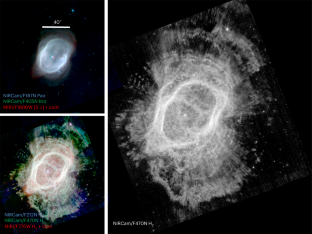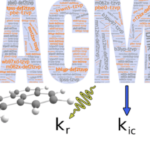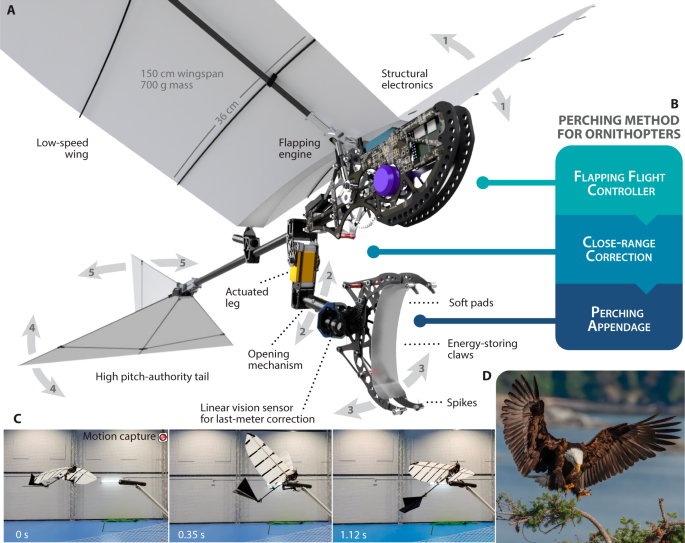国際的な科学者チームが、星の死後に起こる現象について、これまでで最も明確な証拠をつかんだと主張しています。 An international team of scientists claim to have the clearest evidence yet of the events that follow the death of a star.
2022-12-08 カーディフ大学
惑星状星雲は、死にかけた星が吐き出す結び目やフィラメント、ガスなどの雲として知られています。
これまで天文学者は、ほぼ完全な球形である星が、その寿命の終わりに、塊、ジェット、シェル、ハローなどの複雑な星雲をどのように作り出せるのかを理解することが困難であった。
しかし、Nature Astronomy誌に掲載された今回の研究では、NASAの新しい望遠鏡のデータと、宇宙や地上の既存施設のデータを用いて、あまり知られていない星雲の中心にある最大5つの星の系を明らかにすることに成功しました。
カーディフ大学物理学・天文学科の松浦美香子教授(研究員)は、次のように語っています。「この画像を初めて見たとき、星雲の中心部に塵があることに気づきました。これまで塵は超高温の中心星から遠ざかっていくと考えられていたので、これは驚きでした。
JWSTの初期リリース観測プログラムの一環として撮影されたこの画像は、近赤外線カメラと中間赤外線観測装置を用いて、Southern Ring星雲と呼ばれる惑星状星雲NGC 3132の画像を作成したものです。
これまで楕円形と考えられていましたが、JWSTの赤外線観測により、死にかけた星とその伴星の周りに巻きついた風やガスが、Southern Ringの中にある塵の円盤を形成していることが分かりました。
<関連情報>
- https://www.cardiff.ac.uk/news/view/2689016-astronomers-continue-to-unravel-mysteries-of-stellar-afterlife-in-new-images-from-space-telescope
- https://www.nature.com/articles/s41550-022-01845-2
JWSTが観測した多星系の滅茶苦茶な死とその結果の惑星状星雲 The messy death of a multiple star system and the resulting planetary nebula as observed by JWST
Orsola De Marco,Muhammad Akashi,Stavros Akras,Javier Alcolea,Isabel Aleman,Philippe Amram,Bruce Balick,Elvire De Beck,Eric G. Blackman,Henri M. J. Boffin,Panos Boumis,Jesse Bublitz,Beatrice Bucciarelli,Valentin Bujarrabal,Jan Cami,Nicholas Chornay,You-Hua Chu,Romano L. M. Corradi,Adam Frank,D. A. García-Hernández,Jorge García-Rojas,Guillermo García-Segura,Veronica Gómez-Llanos,Denise R. Gonçalves,Martín A. Guerrero,David Jones,Amanda I. Karakas,Joel H. Kastner,Sun Kwok,Foteini Lykou,Arturo Manchado,Mikako Matsuura,Iain McDonald,Brent Miszalski,Shazrene S. Mohamed,Ana Monreal-Ibero,Hektor Monteiro,Rodolfo Montez Jr,Paula Moraga Baez,Christophe Morisset,Jason Nordhaus,Claudia Mendes de Oliveira,Zara Osborn,Masaaki Otsuka,Quentin A. Parker,Els Peeters,Bruno C. Quint,Guillermo Quintana-Lacaci,Matt Redman,Ashley J. Ruiter,Laurence Sabin,Raghvendra Sahai,Carmen Sánchez Contreras,Miguel Santander-García,Ivo Seitenzahl,Noam Soker,Angela K. Speck,Letizia Stanghellini,Wolfgang Steffen,Jesús A. Toalá,Toshiya Ueta,Griet Van de Steene,Hans Van Winckel,Paolo Ventura,Eva Villaver,Wouter Vlemmings,Jeremy R. Walsh,Roger Wesson & Albert A. Zijlstra
Nature Astronomy Published:08 December 2022
DOI:https://doi.org/10.1038/s41550-022-01845-2

Abstract
Planetary nebulae—the ejected envelopes of red giant stars—provide us with a history of the last, mass-losing phases of 90% of stars initially more massive than the Sun. Here we analyse images of the planetary nebula NGC 3132 from the James Webb Space Telescope (JWST) Early Release Observations. A structured, extended hydrogen halo surrounding an ionized central bubble is imprinted with spiral structures, probably shaped by a low-mass companion orbiting the central star at about 40–60 au. The images also reveal a mid-infrared excess at the central star, interpreted as a dusty disk, which is indicative of an interaction with another closer companion. Including the previously known A-type visual companion, the progenitor of the NGC 3132 planetary nebula must have been at least a stellar quartet. The JWST images allow us to generate a model of the illumination, ionization and hydrodynamics of the molecular halo, demonstrating the power of JWST to investigate complex stellar outflows. Furthermore, new measurements of the A-type visual companion allow us to derive the value for the mass of the progenitor of a central star with excellent precision: 2.86 ± 0.06 M⊙. These results serve as pathfinders for future JWST observations of planetary nebulae, providing unique insight into fundamental astrophysical processes including colliding winds and binary star interactions, with implications for supernovae and gravitational-wave systems.



